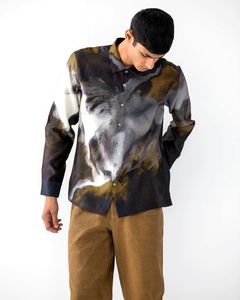Season after season of fashion week, I struggle to find exciting things to say about the event. Don’t get me wrong, I love fashion. And I think Indian fashion has never seen better days. It is aesthetically coming into its own textile-first and craft-friendly space, inviting consumers from India’s giant middle class, and intriguing mega corporations to invest in small businesses, too. It’s just that the fashion week model lives only for emotional reasons; we want to congregate and celebrate in unison. We want to be reminded that we all come from one space. We want to exchange ideas and cigarettes. So, we fashion week.
Last week’s Lakme Fashion Week x FDCI in Mumbai was all those mixed emotions once again. As I pondered over the shows of Rajesh Pratap Singh and JJ Valaya—two stalwart designers whom I have long admired professionally and as people too—I wondered why they even come to a fashion week. Both have been making the same collection over and over again, and while that can be said of so many others too, at least the others have grown their brands in newer and more news-making ways. Singh and Valaya show when their shows are sponsored by someone, and that is the only way they like to communicate to their audience or the press. I have decided to respect designers who respect their own brands.
Gaurav Jai Gupta is doing such wonderful things with his label Akaaro. The textile designer has long been a champion of handwoven and handloomed textiles, especially marrying a beautiful steel thread in his metallic saris and making it his undeniable signature. Gupta has struggled with his tailoring, and I have seen him take baby steps and even falter with shapes. But this season’s collections swept the proverbial rug from under our feet. Called ‘Moonrise’, he used fabric waste to create new clothes, and boy, what a party he had coming up with those designs. Blends of cottons, linens, silks and metallics—Gupta’s Akaaro is so ready for a modern India. I also loved his saris that were draped like couture gowns.
I have been closely watching Amit Hansraj for over three years now—ever since he launched his own terrazzo tiles-inspired label Inca. Hansraj has been a merchandiser with a few leading fashion boutiques and is known to be a great tastemaker in insider circles. During the Covid lockdown, he scratched his entrepreneurial itch with Inca and made easy and elegant kaftans and shirts playing with marble prints. This season he took shibori pants and a shirt and turned them into a sari shape.
Anamika Khanna’s AK-OK was another homage to the queen energy both Khanna and her strongly opinionated consumers exude. An international label, Measure, came from Dagestan, on the border of Russia and Iran, showing us how elegant and edgy modest dressing can be. Designer Zainab Saidulaeva wears a hijab and came here during the holy month of Ramzan to show us her best skills, and won our hearts.
As men’s fashion has come to be such a strong player in India, it would only make sense to have a show presenting only men’s fashion. Three extremely talented and very young labels showcased here—Rishta by Arjun Saluja, Jaywalking and Countrymade. Saluja’s origami shapes have been well-known in his women’s wear for over a decade. Jaywalking is a new streetwear label by 30-year-old Mumbai boy Jay Jajal. Sushant Abrol’s Countrymade marries artisanal work with military shapes and has built a strong following in just four years.
Yes, the fashion week’s glass is only just half full. I’m going to top it with ice and say cheers to that.


